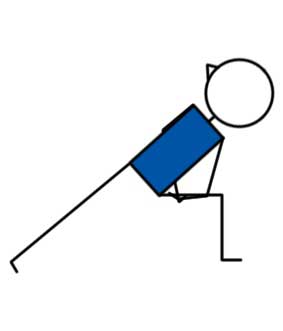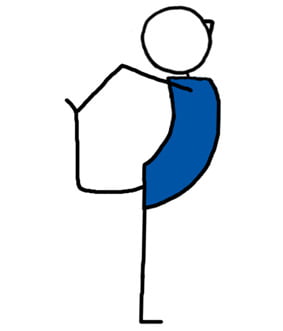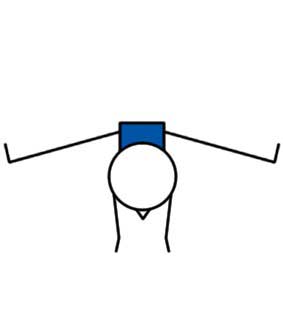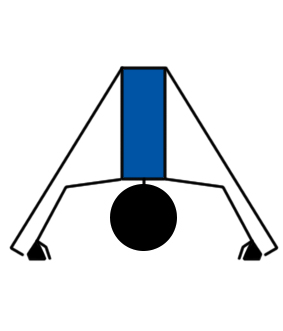
Standing Head To Knee C
| Sanskrit Name: | Dandayamana Janushirasana |
|---|---|
| Similar Pose Names: | Standing head to big toe c, big toe hold c, standing big toe c |
| Category: | Standing |
| Share on: |
 Yoga Lesson Planner
Yoga Lesson Planner
 Pilates Lesson Planner
Pilates Lesson Planner
| Category: | Yoga Lesson Planner |
|---|---|
| Sub Category: | Standing |
| Types: | Balance, Forward Bend, Hip Opener, Prone, Standing, Strengthen, Stretch |
| Anatomy: | Arms & Shoulders, Biceps & Triceps, Core, Hamstrings, Hips, Lower Back, Middle Back, Psoas, Upper Back, Wrists & Arms |
| Chakras: | Base, Sacral Centre, Solar Plexus Centre |
| Therapy: | Leg Congestion, Poor Posture, Varicose Veins |
| Drishti: | Tip Of Nose |
| Dosha: | Kapha, Pitta, Vata |
Stand with feet together. Toes and heels touch. Shift body weight to left leg. Interlace fingers and thumbs (forming a cup with hands). Contract abs, bend at waist, pick up right foot with palms cupping the sole around balls of feet (If you struggle to reach foot, bring right knee up and grab underneath knee cap using same grip). Look forward. Keep left leg locked contracting quads, hams, glutes and abs to keep balance. If left leg is locked without wobbling, extend right leg, with heel pushed away and toes turned back towards face. If you can lock both legs without grip slipping, relax shoulders, drop elbows either side of calf. If you're able to maintain this stage of the pose comfortably, slowly lower head until forehead touches knee and you're looking up your belly button. Hold for five seconds. Slowly reverse out of the pose. Switch legs.
Strengthens thighs, buttocks, hamstrings, calves, ankles. Increases mental strength.
A) Strap looped around sole of foot instead of hooking big toe with fingers and thumb. B) Raised leg on back of chair. C) Use a wall as a prop (to stay in the pose for longer). D) Press raised heel firmly into wall. E) Do the pose lying down in Reclined Big Toe pose.
Knee injury.
Click here for lots of FREE downloadable Yoga lesson plans.
Click here for lots of FREE downloadable Pilates lesson plans.
- Ask Genie1
- Bird Of Paradise Peak Pose
- Bird Of Paradise Peak Pose
- Ask Genie1
- Ask Genie1
- Ask Genie2
- Ask Genie1
- Ask Genie2
- Ask Genie5
- Ask Genie1
- Ask Genie1
- Ask Genie3
- Ask Genie4
- Ask Genie2
- Ask Genie1
- Ask Genie 6
- Ask Genie 4
- Bird Of Paradise Peak Pose
- Ask Genie 2
- Ask Genie 2
- Ask Genie 7
- Ask Genie 1
- Ask Genie 3
- Ask Genie 7
- Ask Genie 17
- Ask Genie 21
- Ask Genie 28
- Bird Of Paradise Peak Pose
- Ask Genie 1
- Ask Genie 5
- Ask Genie 1
- Ask Genie 1
- Ask Genie 1
- Ask Genie 1
- Ask Genie 1
- General yoga class 2
- Ask Genie 1
- Ask Genie 2
- Ask Genie 3
Beginner Tips
Work on your balance first with Tree pose.
Focus on your breath when exiting the pose. Inhale, bring your leg back to the centre. Exhale, lower foot back to floor.
Sanskrit
The Sanskrit name for this pose, “Utthita Hasta Padangusthasana” (oo-TEE-tah HAHS-tuh pahd-ahng-goosh-TAHS-uh-nuh), comes from five words:
“Utthita” — meaning “extended”
“Hasta”— meaning “hand”
“Pada” — meaning “foot”
“Angusta” — meaning “big toe”
“Asana” — meaning “pose”
Benefits Of Balance Poses
Balance is the ability to control your body’s position, whether stationary (i.e. a complex yoga pose) or while moving (e.g. playing golf).
Balance is a key component of Yoga, along with strength and flexibility poses.
Top 5 benefits to of balance poses…
1) Body Awareness – Body awareness is the sense of how your limbs are oriented in space, also known as proprioception. Balance training improves body awareness, which decreases the likelihood of injury.
2) Coordination – Balance poses requires your entire body to work in harmony, otherwise you will fall or stumble. Improved coordination during balance poses will be transferred into coordination in everyday life.
3) Joint Stability – Balance poses promote stable knees, ankles, hips, and shoulders. This can prevent a multitude of injuries including sprained ankles and knee problems.
4) Reaction Time – Balance poses can improve your reaction time. If you happen to slip or stumble when performing balance poses, your body needs to re-balance immediately or you will fall. This in turn will improve your reaction time in everyday life.
5) Long Term Health – Adding balance poses into your Yoga session helps to maintain or improve your balance, which is needed to prevent falls and fractures. As we age, our balance can deteriorate. Yoga balances will help delay that deterioration.










































